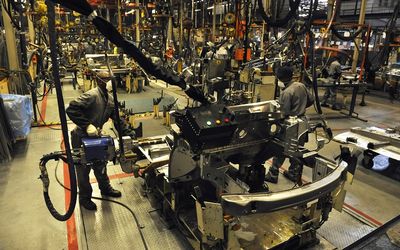DURING the past two decades, SA has become an increasingly service-based, consumption-led economy, with banking, shopping, communication and transport comfortably outperforming most other sectors.
Back in the mid-1990s, the manufacturing sector comprised just over 20% of total economic activity in SA. It has since declined to less than 13% and continues to lose ground. In contrast, the tertiary — or services — sector of the economy has increased from 60% of total output in the mid-1990s to more than 70% this year.
This shift is not necessarily a good thing, as manufacturing activity has a number of important advantages over the services sector. If SA had a larger, more dynamic manufacturing sector catering to consumer demand, a cut in interest rates or increase in social payments would be of much greater impact in stimulating the broader economy, including job creation and private sector fixed-investment spending.
Back in the mid-1990s, slightly more than 50% of total formal sector employment was absorbed in the services sector. This year, it has increased to an incredible 75%. The rise in government employment has been a major component of this increase.
This fundamental shift in the structure of the economy was not intentional. Instead, it reflects the effect of a combination of factors including an apparent lack of global competitiveness in manufacturing, combined with the population’s demand for access to credit, cellphones, transport and branded consumer goods that are largely imported.
The industrial development policies employed by the government to promote manufacturing have varied considerably over time, but have typically included targeted measures to support specific industries; broader support measures applicable to all industries; preferential trade agreements to encourage industrial exports and preferential financial support.
...
WHILE the Department of Trade and Industry and other institutions formulated several potentially useful policies to encourage industrial development over the years, many of these have been too complex in design, poorly communicated and, in many instances, prematurely scrapped.
In the past 20 years, existing and potential industrialists have been unaware of crucial components of SA’s industrial policy because the policy approach has appeared bureaucratic, erratic and inaccessible.
For policy to be highly effective, it needs to be extremely simple, repeated on a regular basis (especially in the early stages of its introduction), demonstrably accessible and available to all.
SA has tried to promote the development of the primary and secondary sectors of the economy, most especially manufacturing activity, because this has several important advantages over the services sector. These include strong backward and forward linkages to other sectors in the economy — a pick-up in manufacturing activity typically boosts many other associated sectors.
Manufacturing entities have the ability to derive valuable economies of scale, so the return on investment is potentially huge as long as capacity utilisation rates remain high, adding significant value to overall economic activity. There is, however, a much more compelling reason why SA should ensure that the manufacturing sector is responsive, confident and growing.
The history of economic policy in SA in the past two decades suggests that the policy officials are, generally, more effective in stimulating the demand side of the economy and not all that effective in boosting the supply side.
SA’s economic policy finds it relatively easy (mainly through the use of interest rates or changes in taxes and social payments) to encourage an increase in consumption spending. It struggles, however, to encourage fixed-investment spending in the form of new business development or the expansion of existing businesses. It also struggles to lift public sector infrastructural development sustainably.
This is because the primary and most frequently used policy tools are typically not accompanied by the deregulation of industry or the development of crucial technical skills or an inspiring improvement of the country’s economic infrastructure, all of which are needed to lift business confidence.
...
IT IS not uncommon for a systematic reduction in interest rates or cut in tax rates to be accompanied by an increase in business regulation or the further deterioration of the economic infrastructure, such as the provision of electricity. This is not done on purpose, but rather because policy initiatives are not well co-ordinated across government departments.
The same problem is evident when government embarks on counter-cyclical fiscal policy. This policy stimulus has, historically, taken the form of increased social spending or increased public sector wages, but not the increased provision of infrastructure or the promotion of research and development and product innovation in the industrial sector. The result is that the supply side of the economy including manufacturing capacity, has stagnated at best, with some sectors experiencing a decline in capacity. At the same time, retail sales have flourished.
Clearly, if SA had a larger, innovative, broad-based and more dynamic manufacturing sector that was consumer-focused and prided itself on product innovation and flexibility, then a cut in interest rates or increase in social payments would have a much greater effect in stimulating the broader economy including job creation and private sector fixed-investment spending. Policy initiatives would be much more effective.
At times, labour has received a significant portion of the blame for SA’s lack of manufacturing competitiveness. This is an unfair generalisation. It is also unfair to argue that labour is expensive without reference to the prevailing cost of living. Low wages don’t necessarily determine the competitiveness of industry.
Through years of isolation, many manufacturing businesses never really understood the need to constantly develop and upgrade their technological capabilities, and, consequently, they lost competitiveness.
Yet without a dynamic, flourishing manufacturing sector, measures to stimulate demand are largely going to lead to an increase in imports, and the economy is going to continue to struggle to gain traction and to create the desperately needed jobs.
• Lings is chief economist at Stanlib

Back in the mid-1990s, the manufacturing sector comprised just over 20% of total economic activity in SA. It has since declined to less than 13% and continues to lose ground. Picture: ROBERT TSHABALALA
DURING the past two decades, SA has become an increasingly service-based, consumption-led economy, with banking, shopping, communication and transport comfortably outperforming most other sectors.
Back in the mid-1990s, the manufacturing sector comprised just over 20% of total economic activity in SA. It has since declined to less than 13% and continues to lose ground. In contrast, the tertiary — or services — sector of the economy has increased from 60% of total output in the mid-1990s to more than 70% this year.
This shift is not necessarily a good thing, as manufacturing activity has a number of important advantages over the services sector. If SA had a larger, more dynamic manufacturing sector catering to consumer demand, a cut in interest rates or increase in social payments would be of much greater impact in stimulating the broader economy, including job creation and private sector fixed-investment spending.
Back in the mid-1990s, slightly more than 50% of total formal sector employment was absorbed in the services sector. This year, it has increased to an incredible 75%. The rise in government employment has been a major component of this increase.
This fundamental shift in the structure of the economy was not intentional. Instead, it reflects the effect of a combination of factors including an apparent lack of global competitiveness in manufacturing, combined with the population’s demand for access to credit, cellphones, transport and branded consumer goods that are largely imported.
The industrial development policies employed by the government to promote manufacturing have varied considerably over time, but have typically included targeted measures to support specific industries; broader support measures applicable to all industries; preferential trade agreements to encourage industrial exports and preferential financial support.
...
WHILE the Department of Trade and Industry and other institutions formulated several potentially useful policies to encourage industrial development over the years, many of these have been too complex in design, poorly communicated and, in many instances, prematurely scrapped.
In the past 20 years, existing and potential industrialists have been unaware of crucial components of SA’s industrial policy because the policy approach has appeared bureaucratic, erratic and inaccessible.
For policy to be highly effective, it needs to be extremely simple, repeated on a regular basis (especially in the early stages of its introduction), demonstrably accessible and available to all.
SA has tried to promote the development of the primary and secondary sectors of the economy, most especially manufacturing activity, because this has several important advantages over the services sector. These include strong backward and forward linkages to other sectors in the economy — a pick-up in manufacturing activity typically boosts many other associated sectors.
Manufacturing entities have the ability to derive valuable economies of scale, so the return on investment is potentially huge as long as capacity utilisation rates remain high, adding significant value to overall economic activity. There is, however, a much more compelling reason why SA should ensure that the manufacturing sector is responsive, confident and growing.
The history of economic policy in SA in the past two decades suggests that the policy officials are, generally, more effective in stimulating the demand side of the economy and not all that effective in boosting the supply side.
SA’s economic policy finds it relatively easy (mainly through the use of interest rates or changes in taxes and social payments) to encourage an increase in consumption spending. It struggles, however, to encourage fixed-investment spending in the form of new business development or the expansion of existing businesses. It also struggles to lift public sector infrastructural development sustainably.
This is because the primary and most frequently used policy tools are typically not accompanied by the deregulation of industry or the development of crucial technical skills or an inspiring improvement of the country’s economic infrastructure, all of which are needed to lift business confidence.
...
IT IS not uncommon for a systematic reduction in interest rates or cut in tax rates to be accompanied by an increase in business regulation or the further deterioration of the economic infrastructure, such as the provision of electricity. This is not done on purpose, but rather because policy initiatives are not well co-ordinated across government departments.
The same problem is evident when government embarks on counter-cyclical fiscal policy. This policy stimulus has, historically, taken the form of increased social spending or increased public sector wages, but not the increased provision of infrastructure or the promotion of research and development and product innovation in the industrial sector. The result is that the supply side of the economy including manufacturing capacity, has stagnated at best, with some sectors experiencing a decline in capacity. At the same time, retail sales have flourished.
Clearly, if SA had a larger, innovative, broad-based and more dynamic manufacturing sector that was consumer-focused and prided itself on product innovation and flexibility, then a cut in interest rates or increase in social payments would have a much greater effect in stimulating the broader economy including job creation and private sector fixed-investment spending. Policy initiatives would be much more effective.
At times, labour has received a significant portion of the blame for SA’s lack of manufacturing competitiveness. This is an unfair generalisation. It is also unfair to argue that labour is expensive without reference to the prevailing cost of living. Low wages don’t necessarily determine the competitiveness of industry.
Through years of isolation, many manufacturing businesses never really understood the need to constantly develop and upgrade their technological capabilities, and, consequently, they lost competitiveness.
Yet without a dynamic, flourishing manufacturing sector, measures to stimulate demand are largely going to lead to an increase in imports, and the economy is going to continue to struggle to gain traction and to create the desperately needed jobs.
• Lings is chief economist at Stanlib




























Change: 1.20%
Change: 1.20%
Change: 1.61%
Change: 0.95%
Change: 1.37%
Data supplied by Profile Data
Change: 0.64%
Change: 0.01%
Change: 1.20%
Change: 0.00%
Change: 0.07%
Data supplied by Profile Data
Change: 0.42%
Change: 0.16%
Change: 1.01%
Change: 0.73%
Change: 1.32%
Data supplied by Profile Data
Change: -0.16%
Change: 0.21%
Change: 0.56%
Change: 0.98%
Change: -0.17%
Data supplied by Profile Data